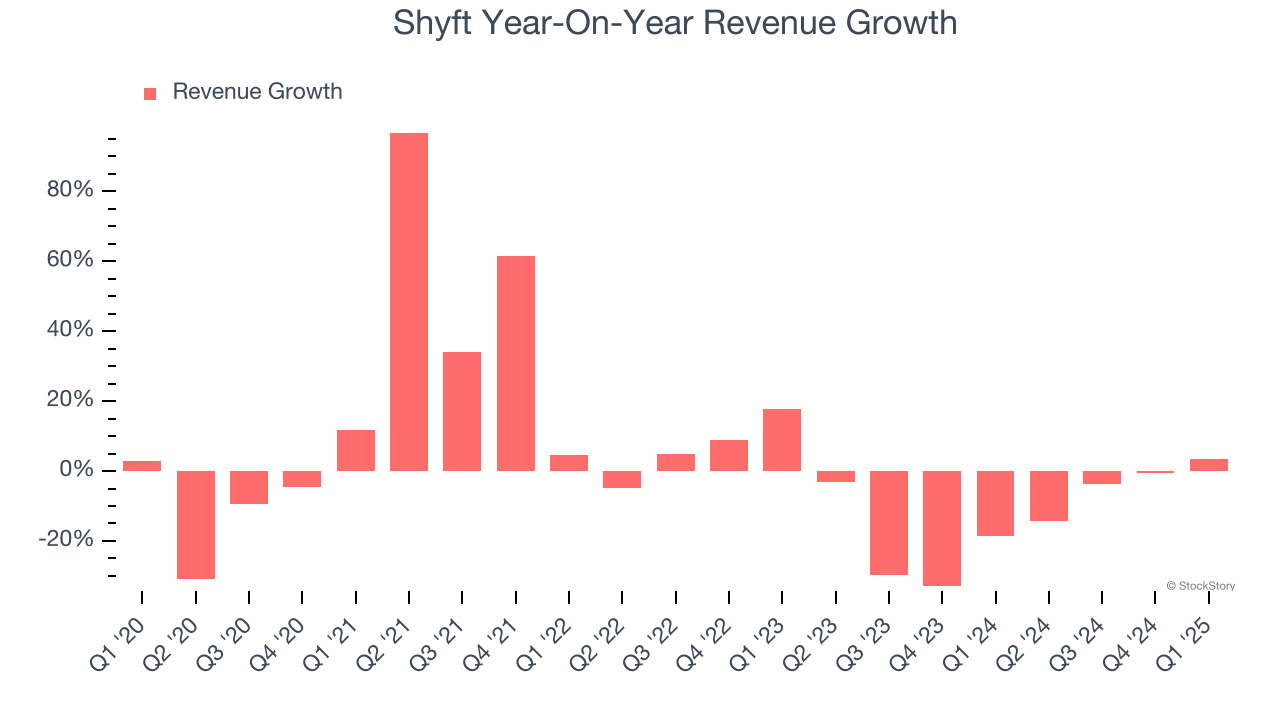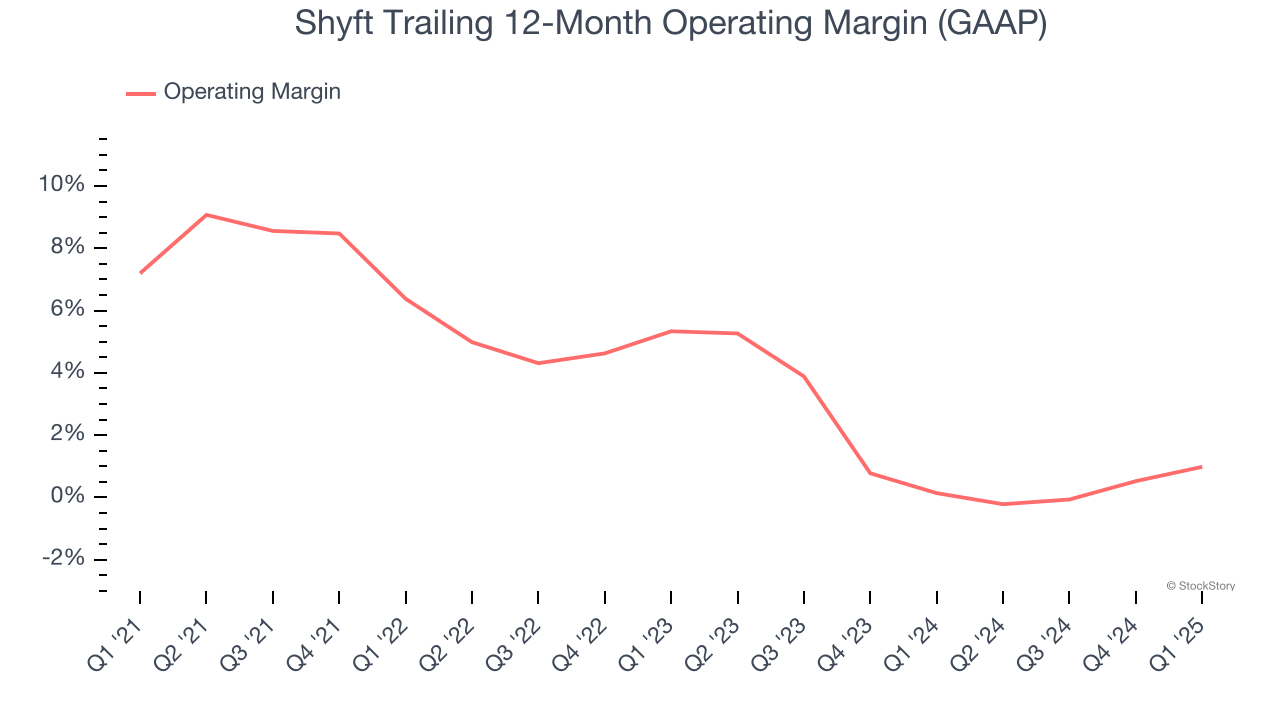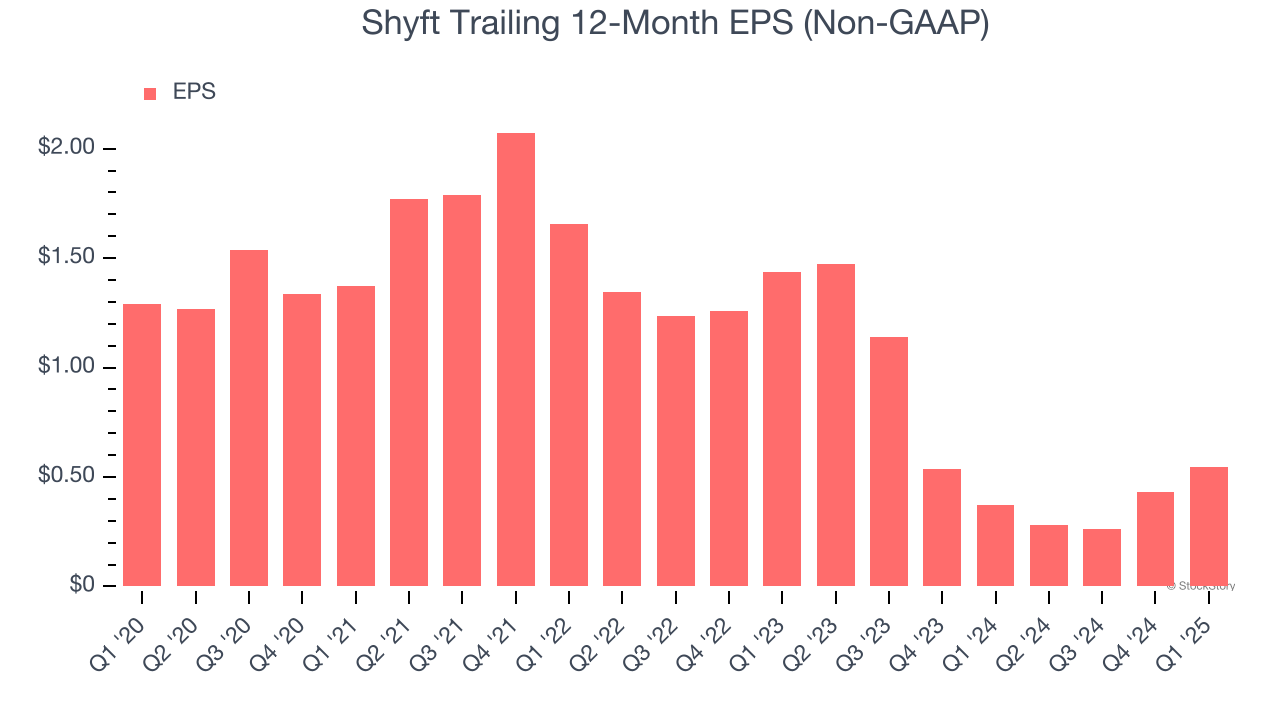
Vehicle manufacturer Shyft (NASDAQ:SHYF) reported revenue ahead of Wall Street’s expectations in Q1 CY2025, with sales up 3.4% year on year to $204.6 million. The company’s full-year revenue guidance of $920 million at the midpoint came in 3.8% above analysts’ estimates. Its non-GAAP profit of $0.07 per share was significantly above analysts’ consensus estimates.
Is now the time to buy Shyft? Find out by accessing our full research report, it’s free.
Shyft (SHYF) Q1 CY2025 Highlights:
- Revenue: $204.6 million vs analyst estimates of $198.9 million (3.4% year-on-year growth, 2.8% beat)
- Adjusted EPS: $0.07 vs analyst estimates of -$0.10 (significant beat)
- Adjusted EBITDA: $12.28 million vs analyst estimates of $3.19 million (6% margin, significant beat)
- The company reconfirmed its revenue guidance for the full year of $920 million at the midpoint
- Management reiterated its full-year Adjusted EPS guidance of $0.80 at the midpoint
- EBITDA guidance for the full year is $67 million at the midpoint, above analyst estimates of $63.36 million
- Operating Margin: 0.9%, up from -1% in the same quarter last year
- Free Cash Flow was -$9.50 million compared to -$9.68 million in the same quarter last year
- Market Capitalization: $255 million
"We are pleased with our start to the year and the team's ability to deliver better than expected financial results," said John Dunn, President and CEO.
Company Overview
Notably receiving an order from FedEx for electric vehicles, Shyft (NASDAQ:SHYF) offers specialty vehicles and truck bodies for various industries.
Heavy Transportation Equipment
Heavy transportation equipment companies are investing in automated vehicles that increase efficiencies and connected machinery that collects actionable data. Some are also developing electric vehicles and mobility solutions to address customers’ concerns about carbon emissions, creating new sales opportunities. Additionally, they are increasingly offering automated equipment that increases efficiencies and connected machinery that collects actionable data. On the other hand, heavy transportation equipment companies are at the whim of economic cycles. Interest rates, for example, can greatly impact the construction and transport volumes that drive demand for these companies’ offerings.
Sales Growth
Reviewing a company’s long-term sales performance reveals insights into its quality. Any business can put up a good quarter or two, but many enduring ones grow for years. Unfortunately, Shyft struggled to consistently increase demand as its $792.9 million of sales for the trailing 12 months was close to its revenue five years ago. This wasn’t a great result and suggests it’s a low quality business.

Long-term growth is the most important, but within industrials, a half-decade historical view may miss new industry trends or demand cycles. Shyft’s recent performance shows its demand remained suppressed as its revenue has declined by 13.7% annually over the last two years. Shyft isn’t alone in its struggles as the Heavy Transportation Equipment industry experienced a cyclical downturn, with many similar businesses observing lower sales at this time. 
Shyft also breaks out the revenue for its most important segments, Fleet Vehicles and Specialty Vehicles , which are 47% and 40.2% of revenue. Over the last two years, Shyft’s Fleet Vehicles revenue (commercial delivery vehicles) averaged 20.1% year-on-year declines while its Specialty Vehicles revenue ( RV chassis and truck bodies) averaged 4.6% declines.
This quarter, Shyft reported modest year-on-year revenue growth of 3.4% but beat Wall Street’s estimates by 2.8%.
Looking ahead, sell-side analysts expect revenue to grow 15.5% over the next 12 months, an improvement versus the last two years. This projection is eye-popping and suggests its newer products and services will fuel better top-line performance.
Today’s young investors won’t have read the timeless lessons in Gorilla Game: Picking Winners In High Technology because it was written more than 20 years ago when Microsoft and Apple were first establishing their supremacy. But if we apply the same principles, then enterprise software stocks leveraging their own generative AI capabilities may well be the Gorillas of the future. So, in that spirit, we are excited to present our Special Free Report on a profitable, fast-growing enterprise software stock that is already riding the automation wave and looking to catch the generative AI next.
Operating Margin
Operating margin is an important measure of profitability as it shows the portion of revenue left after accounting for all core expenses – everything from the cost of goods sold to advertising and wages. It’s also useful for comparing profitability across companies with different levels of debt and tax rates because it excludes interest and taxes.
Shyft was profitable over the last five years but held back by its large cost base. Its average operating margin of 4.1% was weak for an industrials business. This result isn’t too surprising given its low gross margin as a starting point.
Looking at the trend in its profitability, Shyft’s operating margin decreased by 6.2 percentage points over the last five years. Shyft’s performance was poor no matter how you look at it - it shows that costs were rising and it couldn’t pass them onto its customers.

This quarter, Shyft’s breakeven margin was up 1.8 percentage points year on year. Since its gross margin expanded more than its operating margin, we can infer that leverage on its cost of sales was the primary driver behind the recently higher efficiency.
Earnings Per Share
Revenue trends explain a company’s historical growth, but the long-term change in earnings per share (EPS) points to the profitability of that growth – for example, a company could inflate its sales through excessive spending on advertising and promotions.
Sadly for Shyft, its EPS declined by 15.8% annually over the last five years while its revenue was flat. This tells us the company struggled because its fixed cost base made it difficult to adjust to choppy demand.

Diving into the nuances of Shyft’s earnings can give us a better understanding of its performance. As we mentioned earlier, Shyft’s operating margin improved this quarter but declined by 6.2 percentage points over the last five years. This was the most relevant factor (aside from the revenue impact) behind its lower earnings; taxes and interest expenses can also affect EPS but don’t tell us as much about a company’s fundamentals.
Like with revenue, we analyze EPS over a more recent period because it can provide insight into an emerging theme or development for the business.
For Shyft, its two-year annual EPS declines of 38.4% show it’s continued to underperform. These results were bad no matter how you slice the data.
In Q1, Shyft reported EPS at $0.07, up from negative $0.04 in the same quarter last year. This print easily cleared analysts’ estimates, and shareholders should be content with the results. Over the next 12 months, Wall Street expects Shyft’s full-year EPS of $0.55 to grow 96.9%.
Key Takeaways from Shyft’s Q1 Results
We were impressed by how significantly Shyft blew past analysts’ EPS and EBITDA expectations this quarter. We were also excited its full-year EBITDA guidance and revenue outperformed Wall Street’s estimates. Zooming out, we think this was a good quarter with some key areas of upside. The stock traded up 7% to $7.80 immediately following the results.
Shyft had an encouraging quarter, but one earnings result doesn’t necessarily make the stock a buy. Let’s see if this is a good investment. If you’re making that decision, you should consider the bigger picture of valuation, business qualities, as well as the latest earnings. We cover that in our actionable full research report which you can read here, it’s free.
